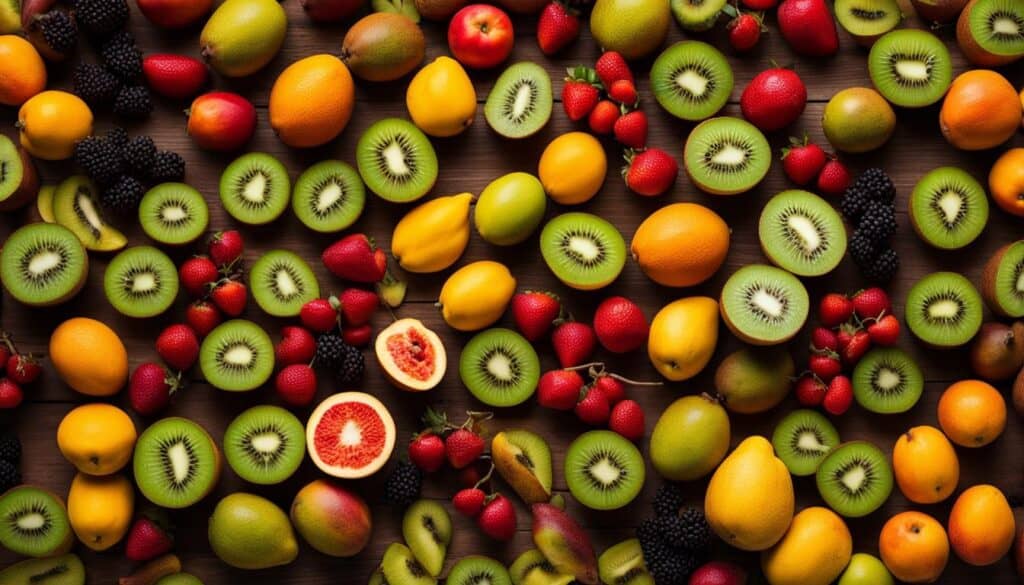Welcome to my guide on bringing fruit into Canada! Whether you’re a traveler or purchasing food online, it’s important to be aware of the federal import requirements that apply when bringing food into Canada for personal use. Understanding these regulations, restrictions, and necessary permits will ensure a smooth process when bringing fruit into Canada.
Key Takeaways:
- Before bringing food into Canada, find out if it is allowed and what conditions apply.
- There are specific import regulations for both food products and pets.
- Fresh fruits and vegetables, animal and fish products, certain weapons, illegal drugs, and cannabis are prohibited at the Canadian border.
- Always declare your food or items to customs and follow the guidelines for smooth border crossings.
- Stay informed about any changes in regulations and consult official sources for up-to-date information.
Food Import Regulations for Personal Use in Canada
When bringing food into Canada for personal use, it is important to understand the import regulations. According to the Safe Food for Canadian Regulations, travelers can carry food with them for their own personal use, as long as it falls within the specified personal exemption limits. This exemption applies if the food is solely for personal use and the quantity does not exceed the limits set by the Canadian Food Inspection Agency (CFIA). It is essential to be familiar with the maximum quantity limits and any additional duties or taxes that may apply to imported foods. The regulations aim to ensure the safety and integrity of the food being brought into Canada.
“Travelers can carry food with them for their own personal use, as long as it falls within the specified personal exemption limits.”
When bringing food into Canada, it is crucial to be aware of the restrictions and requirements. The CFIA has established guidelines to protect Canada’s ecosystems and prevent the introduction of invasive species and foreign diseases. In addition to the personal exemption limits, certain items may be prohibited or restricted, such as fresh fruits and vegetables, animal and fish products, and certain types of weapons. It is important to declare all food items to customs and ensure compliance with the regulations to avoid any legal issues or delays at the border.
To ensure a smooth border crossing experience when bringing food into Canada, it is recommended to verify the import requirements for your specific items and familiarize yourself with any potential hitchhikers that may pose a threat to Canada’s ecosystems. Cleaning all soil and organic debris from items is also crucial to prevent the introduction of pests or diseases. By following these tips and adhering to the import regulations, travelers can enjoy a hassle-free journey into Canada with their personal food items.
| Food Category | Personal Exemption Limit |
|---|---|
| Fruits and Vegetables | 20 kilograms |
| Dairy Products | 20 kilograms |
| Meat and Poultry | 20 kilograms |
| Fish and Seafood | 20 kilograms |
| Grains | 20 kilograms |
| Processed Foods | 20 kilograms |
“The personal exemption limits for various food categories in Canada.”
Allowed Food Products from the United States
If you are planning to bring food products from the United States into Canada, it is important to be aware of the specific regulations and allowed items. The Canadian Food Inspection Agency (CFIA) has established a list of food products that are permitted for import from the United States. These include a wide range of items, such as dairy products, fresh fruits and vegetables, meat products, nuts and grains, oils, spices, tea, coffee, and more.
Each product category may have its own restrictions and maximum quantity limits that need to be followed. It is crucial to check the CFIA regulations and ensure compliance with the specific requirements for the items you intend to bring. Adhering to these regulations will help ensure a smooth border crossing experience and avoid any legal issues.
| Food Product Category | Allowed Items | Maximum Quantity Limits |
|---|---|---|
| Dairy Products | Cheese, milk, yogurt | Varies depending on the product |
| Fresh Fruits and Vegetables | Apples, oranges, carrots, tomatoes | Varies depending on the product |
| Meat Products | Beef, chicken, pork | 20 kg (44 lbs) per person |
| Nuts and Grains | Almonds, rice, oats | Varies depending on the product |
| Oils, Spices, Tea, Coffee | Olive oil, black pepper, green tea, Arabica coffee | Varies depending on the product |
It is important to note that these regulations can change over time, so it is recommended to regularly check the CFIA website for the most up-to-date information. By staying informed and following the guidelines, you can have a hassle-free experience when bringing food products from the United States into Canada.
Allowed Food Products from Outside the United States

If you’re planning to bring food products from a foreign country into Canada, it’s important to know which items are allowed and the maximum quantity limits. The Canadian Food Inspection Agency (CFIA) has provided a list of permitted food products, similar to the list for items from the United States.
These permitted food products from foreign countries include a wide range of items such as animal fat or suet, bread, pastries, cakes, fruit pies, biscuits, condiments, confectionery, dressings, dairy products, dried foods, eggs and processed egg products, fish and seafood, fresh fruits or vegetables, game animal carcasses, grain-derived foods, honey, infant formula, maple syrup and products, multi-ingredient foods, non-alcoholic beverages, nuts, grains, seeds, oils, spices, tea, coffee, and more. Each product category may have its own restrictions and maximum quantity limits that need to be followed.
| Food Category | Permitted Items | Maximum Quantity Limits |
|---|---|---|
| Fruits and Vegetables | Fresh fruits or vegetables without soil | Up to 15 units or 250 g per person, whichever is less |
| Dairy Products | Butter, cheese, milk, yogurt, ice cream, and more | Up to 20 kg per person |
| Meat Products | Beef, pork, poultry, game meats, and more | Up to 20 kg per person |
| Grain-Derived Foods | Bread, pasta, cereals, rice, flour, and more | Up to 20 kg per person |
| Non-Alcoholic Beverages | Juices, sodas, water, energy drinks, and more | Up to 20 L per person |
It’s important to note that these limits are subject to change, so it’s always a good idea to check the CFIA website or consult with the Canadian customs officials to get the most up-to-date information before bringing food products from foreign countries into Canada.
By being aware of the allowed food products and their maximum quantity limits, you can ensure a smooth border crossing experience and comply with the import regulations set by the CFIA. It’s essential to declare your food products to customs and follow any additional requirements or permits that may be necessary. This will help protect Canada’s ecosystems and ensure the safety and integrity of the food being brought into the country.
Prohibited Food Items at the Canadian Border
When crossing the Canadian border, it is important to be aware of the food items that are prohibited or restricted from entering the country. These restrictions are in place to protect Canada’s ecosystems and prevent the introduction of invasive species and foreign diseases. To ensure a smooth border crossing and avoid any legal issues, it is crucial to familiarize yourself with the list of prohibited food items.
Prohibited Food Items
| Category | Examples |
|---|---|
| Fresh Fruits and Vegetables | Apples, oranges, bananas, tomatoes, potatoes |
| Animal and Fish Products | Meat, poultry, dairy products, eggs, live fish |
| Other Prohibited Items | Illegal drugs, cannabis products, certain weapons |
It is important to note that prohibited food items cannot be brought into Canada under any circumstances. This includes both fresh and packaged food items. Travelers should be cautious and ensure that they do not have any prohibited food items in their possession when crossing the Canadian border. Failure to comply with these regulations can result in penalties and legal consequences.
Remember: Always declare any food items to customs when crossing the border. It is better to be safe and transparent about what you are bringing into the country.
By being aware of the food restrictions at the Canadian border and following the regulations, you can help protect Canada’s ecosystems and contribute to the preservation of the country’s natural resources.
Bringing Pets to Canada
When planning to bring your pet to Canada, it’s important to familiarize yourself with the specific regulations and requirements. As a responsible pet owner, you need to ensure that your furry friend meets all the necessary criteria for a smooth and hassle-free entry into the country. Below, I’ve outlined some essential information regarding pet import regulations in Canada:
“To bring a dog or cat to Canada, you must have a signed and dated certificate from your veterinarian stating that your pet has been vaccinated against rabies within the last three years.”
If your pet is under three months old, you won’t be required to provide a certificate of rabies vaccination. However, it’s always a good idea to keep your pet’s vaccination records handy during your travels to Canada. These guidelines are in place to ensure the safety and well-being of both your pet and other animals in Canada.
It’s crucial to note that specific documentation may be required based on the type of pet you’re bringing into the country. For example, if you’re traveling with an exotic animal or a bird, you may need to obtain additional permits or certificates. It’s always best to check with the Canadian Food Inspection Agency (CFIA) or the official government websites for the most up-to-date information.
Pet Import Regulations
When bringing pets to Canada, it’s important to adhere to the following guidelines:
- Ensure your pet is up to date with all necessary vaccinations, including rabies.
- Obtain a signed and dated certificate from your veterinarian as proof of vaccination.
- Research and comply with any additional requirements for specific pet types.
- Carry all relevant documentation with you during your travel to Canada.
- Consult official government sources for the most accurate and current information.
By following these regulations and being prepared with the required documentation, you can ensure a hassle-free entry for your beloved pet when traveling to Canada.
Prohibited Weapons at the Canadian Border

When crossing the Canadian border, it is important to be aware of the regulations regarding the import of weapons. Certain items are strictly prohibited and cannot be brought into Canada. The import of guns and firearms, ammunition, fireworks, mace, and pepper spray is not allowed. These restrictions are in place to ensure the safety and security of Canada’s borders and its citizens.
If you are traveling with a firearm for an official hunting or sporting event, you must declare your firearms to customs at the border and complete a non-resident firearms declaration form. This form ensures that you are in compliance with the import regulations for firearms. Failure to declare your firearm or submit the necessary documentation can result in legal consequences and confiscation of the weapon.
It is important to familiarize yourself with the specific import regulations for firearms before traveling to Canada. This will help ensure a smooth border crossing and prevent any unnecessary delays or legal issues. For more information on the import of firearms, it is recommended to consult official sources or contact the Canadian Border Services Agency (CBSA).
| Prohibited Weapons | Allowed Weapons |
|---|---|
| Guns and firearms | Bows and crossbows |
| Ammunition | Hunting knives |
| Fireworks | Blunt objects (e.g., baseball bats) |
| Mace and pepper spray | Tasers and stun guns |
It is important to note that the table above is not exhaustive and is provided for illustrative purposes only. It is crucial to check the specific regulations and guidelines set by the CBSA to ensure compliance when bringing weapons or other items across the Canadian border.
Staying Informed and Compliant
Ensuring a smooth and hassle-free border crossing requires staying informed and compliant with the import regulations. It is recommended to review the CBSA website or consult with customs officials for the most up-to-date information before your trip. By understanding and following the rules, you can help maintain the safety and security of Canada’s borders while enjoying your travels.
Traveling with Cannabis to Canada

When it comes to traveling with cannabis to Canada, it’s important to understand the country’s import regulations. Despite the legalization of cannabis in both Washington (across the border from Vancouver) and Canada, it is not allowed to bring cannabis from Washington into Canada. Even with a prescription for medical cannabis, it is prohibited to bring marijuana into Canada, including CBD oil and other cannabis products. Travelers should be aware of the laws and regulations surrounding cannabis importation to avoid any legal consequences.
Canada has strict laws on cannabis importation to ensure the safety and well-being of its citizens. While it may be legal to possess and consume cannabis in certain regions, crossing international borders with cannabis remains a violation of Canadian law. It’s important to respect these regulations to avoid any legal penalties or complications during your travels to Canada.
When crossing the Canadian border, customs agents have the authority to search individuals and their belongings. If cannabis is discovered, it can result in criminal charges, including fines and potential imprisonment. To ensure a smooth and hassle-free border crossing, it is strongly advised not to bring any cannabis or cannabis products into Canada.
Travel Tips for Visitors:
- Research the Canadian laws and regulations surrounding cannabis importation before your trip.
- Leave all cannabis and cannabis products at home to avoid any legal consequences or complications.
- Be honest with customs agents if asked about cannabis. Lying or attempting to hide cannabis can lead to more severe penalties.
- Take the time to understand the cultural differences and expectations surrounding cannabis in Canada.
- If you have any questions or concerns regarding cannabis importation, consult with legal professionals or Canadian authorities.
By following these guidelines and respecting the laws of the country, visitors to Canada can ensure a pleasant and worry-free travel experience.
Tips for Smooth Border Crossings

When it comes to crossing the Canadian border, there are a few key tips that can help ensure a smooth and hassle-free experience. Whether you’re bringing food, pets, or other items into Canada, following these tips will help you navigate the border crossing process more efficiently.
Tip 1: Verify the import requirements
Before crossing the border, it’s important to verify the specific import requirements for the items you’re bringing into Canada. Each category of items may have different regulations and restrictions, so taking the time to understand what’s allowed and what’s not can save you from potential complications at the border.
Tip 2: Declare your items to customs
Always declare the food, pets, or other items you’re bringing with you to the Canadian customs officers. This includes any fruits, vegetables, animal products, firearms, or cannabis products. Being honest and transparent about what you’re bringing will help avoid any issues and ensure compliance with Canadian import regulations.
Tip 3: Clean your items and avoid contact with animals
To protect Canada’s ecosystems, it’s important to clean all soil and organic debris from the items you’re bringing, especially if they’re related to agriculture, such as fruits and vegetables. Additionally, to prevent the spread of disease, it’s advised to avoid contact with farmed animals, zoo animals, or wildlife for 14 days after arriving in Canada if you had contact with similar animals in other countries.
Tip 4: Prepare your documentation
Make sure you have all the necessary paperwork and documentation ready when crossing the Canadian border. This may include vaccination certificates for pets, permits for firearms, or any additional paperwork required for specific items. Being organized and prepared will help facilitate the border crossing process.
Summing It Up
Smooth border crossings into Canada can be achieved by following a few simple tips. By verifying the import requirements, declaring your items to customs, cleaning your items, avoiding contact with animals, and preparing your documentation, you can ensure a hassle-free experience at the Canadian border. Remember to stay up-to-date with any changes in regulations and consult official sources for the most accurate information on bringing items into Canada.
Conclusion
In conclusion, bringing fruit into Canada requires compliance with import regulations to protect the country’s ecosystems and prevent the introduction of invasive species and foreign diseases. It is crucial for travelers to be aware of the restrictions and requirements before attempting to bring fruit into Canada.
By understanding and following the guidelines set by the Canadian Food Inspection Agency (CFIA), travelers can ensure a smooth border crossing experience. It is important to stay informed about any changes in regulations and consult official sources for the most up-to-date information on bringing food into Canada.
Remember to always declare your food items to customs and be prepared to provide any necessary permits or documents. Keeping abreast of the maximum quantity limits and any additional duties or taxes that may apply to imported foods will help avoid any legal issues.
Overall, by respecting the import regulations and taking precautions to protect Canada’s ecosystems, travelers can safely bring fruit into the country and enjoy their visit without any disruptions or setbacks.
FAQ
Can I bring fruit into Canada for personal use?
Yes, you can bring fruit into Canada for personal use, but there are certain import regulations and restrictions that apply. It is important to be aware of these regulations to ensure compliance.
What are the import requirements for bringing food into Canada?
When bringing food into Canada, you need to find out if the item is allowed and under what conditions. There may be restrictions based on the type of food, country of origin, and the Canadian province you are bringing it to. It is essential to declare the product and ensure compliance with any necessary permits or documents.
What food products are allowed from the United States?
The Canadian Food Inspection Agency (CFIA) has established a list of food products that are allowed into Canada from the United States. These include items such as animal fat or suet, baked goods, condiments, dairy products, dried foods, eggs and processed egg products, fish and seafood, fresh fruits or vegetables, game animal carcasses, grain-derived foods, honey, infant formula, maple syrup and products, meat products, multi-ingredient foods, non-alcoholic beverages, nuts, grains, seeds, oils, spices, tea, and coffee.
What food products are allowed from foreign countries?
Apart from the United States, Canada permits the import of certain food products from foreign countries. The CFIA provides a list of food products that are permitted from countries other than the United States. This includes items such as animal fat or suet, bread, pastries, cakes, fruit pies, biscuits, condiments, confectionery, dressings, dairy products, dried foods, eggs and processed egg products, fish and seafood, fresh fruits or vegetables, game animal carcasses, grain-derived foods, honey, infant formula, maple syrup and products, multi-ingredient foods, non-alcoholic beverages, nuts, grains, seeds, oils, spices, tea, coffee, and more.
What food items are prohibited at the Canadian border?
Certain food items, such as fresh fruits and vegetables and animal and fish products, are not allowed to be brought into Canada. These restrictions are in place to protect Canada’s ecosystems and prevent the introduction of invasive species and foreign diseases. It is important to be aware of the list of prohibited food items to avoid any issues at the border.
What are the regulations for bringing pets to Canada?
To bring a dog or cat to Canada, you must have a signed and dated certificate from your veterinarian stating that your pet has been vaccinated against rabies within the last three years. If your pet is less than three months old, a certificate of rabies vaccination is not required. It is important to ensure all necessary vaccinations and paperwork are in order before traveling with your pet to Canada.
What weapons are prohibited at the Canadian border?
Guns and firearms, ammunition, fireworks, and mace and pepper spray are not allowed to be brought into Canada. If you are traveling with a firearm for an official hunting or sporting event, you must report your firearms to customs at the border and complete a non-resident firearms declaration form.
Can I bring cannabis into Canada?
Despite the legalization of cannabis in both Washington (across the border from Vancouver) and Canada, it is not allowed to bring cannabis from Washington into Canada. Even with a prescription for medical cannabis, it is prohibited to bring marijuana into Canada, including CBD oil and other cannabis products.
What are some tips for smooth border crossings?
To ensure a smooth border crossing when bringing food or other items into Canada, consider verifying the import requirements for your specific items, checking for any hitchhikers that could pose a threat to Canada’s ecosystems, cleaning all soil and organic debris from items, always declaring your food or items to customs, and avoiding contact with farmed animals, zoo animals, or wildlife for 14 days after arriving in Canada if you had contact with similar animals in other countries.
What should I know about bringing fruit into Canada?
Bringing fruit into Canada requires adherence to import regulations to ensure the safety of Canada’s ecosystems and protect against invasive species and foreign diseases. By understanding the restrictions and requirements, travelers can enjoy a smooth border crossing experience and avoid any legal issues. It is important to stay informed about any changes in regulations and consult official sources for the most up-to-date information on bringing food into Canada.





Leave a Reply